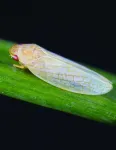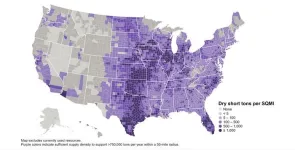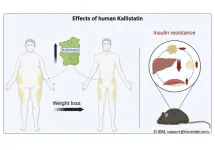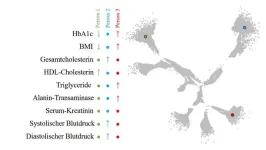(Press-News.org) UNDER EMBARGO UNTIL MARCH 18, 2024 AT 3:00 PM U.S. EASTERN TIME
Renewable energy sources are essential for transitioning towards a decarbonized energy system and making the electricity grid more environmentally sustainable. Clean energy alternatives like wind power can effectively replace fossil fuels, contributing to reduced air pollution and slow down climate change.
Wind power has emerged as the fastest-growing non-hydro renewable energy source worldwide. However, the implementation of wind energy infrastructure, including windmills, faces significant challenges. One major obstacle is the opposition from local communities.
Wind turbines, the primary components of wind power generation, can be noisy, obstruct sunlight, produce flickering lights, and disrupt scenic views. These concerns can lead to conflicts between renewable energy development and environmental preservation, potentially exacerbating existing social inequalities.
A study published in the journal Proceedings of the National Academy of Sciences (PNAS) by an international team of scientists, including researchers from CMCC, the Potsdam Institute for Climate Impact Research (PIK), and University of California at Berkeley, offers a comprehensive perspective on this issue, crucial for evaluating the trade-offs between the benefits and costs of renewable energy sources, and for gaining a thorough understanding of their impacts.
This study represents a unique evaluation of the externality costs of wind power generation, specifically focusing on the impact of visibility on property values across the United States.
“This situation is a classic 'Not In My Backyard' problem, which leads to extensive policy debates on renewable energy growth,” says Wei Guo, researcher at CMCC and EIEE, the European Institute on Economics and the Environment, and first author of the study. “In the big picture, the economic solution is about finding a balance between the global environmental benefits of renewable energy and the local impacts on communities nearby.”
The research focuses on the impact of wind power generation on local communities, which is usually overlooked. Specifically, the study addresses how wind turbines, when integrated into the landscape, influence the perceived value of homes by residents. The main aim is to contribute to the benefit and cost analysis of renewable energy development, facilitating more informed decision-making for both policymakers and the public regarding new projects.
In pursuit of this objective, the researchers have meticulously compiled a database on wind turbine visibility, incorporating details on the location and height of each utility-scale turbine that has contributed power to the U.S. grid. The database is complemented by a high-resolution elevation map, which accounts for the underlying topography of the landscape. Grounded in hedonic valuation theory, the researchers conducted statistical estimations to discern the impact of wind turbine visibility on home values. These estimations draw on data sourced from a comprehensive dataset covering the majority of home sales in the U.S.A. since 1997.
The study reveals that, on average, the visibility of wind turbines has a negative and economically significant impact on home values within proximity of less than 8 km. However, this effect becomes indistinguishable from zero at larger distances. Moreover, the impact is notably smaller for recently installed turbines and diminishes significantly over time following their installation. The findings shed light on the nuanced dynamics between renewable energy infrastructure and local property values, providing valuable insights for sustainable and community-friendly energy development.
The results of the study show that seeing a windmill closer than 2 kilometers away can lower a house’s value by up to 8%. “To picture this, imagine holding a golf ball at arm's length - that is roughly how big a wind turbine looks from that distance,” says Guo. “However, as one moves further from the windmill, its impact on house values drops off quickly. From 8 kilometers away, a wind turbine looks about as big as an aspirin tablet at arm’s length, and at this distance, it doesn't really affect what people think their homes are worth.”
The total loss in values across all US houses with a view of windmills adds up to a drop of US $24.5 billion. Although this is a significant loss, it amounts to a relatively small fraction when comparing it to the total value of all homes in the US – over $45 trillion in 2022.
“We conclude that although houses close to wind turbines can lose some value due to the disrupted view, the impacts are just a small part in the grand theme of all houses, and we expect it to become even less an issue in the future,” says Guo. “This project stands at the cutting edge of understanding how renewable energy affects local communities. It is like putting on a new pair of glasses to look at how wind power impacts people's lives and homes.”
This research pioneered a comprehensive nationwide evaluation of the external costs of wind power generation, but it also marks a significant advancement in quantitative precision by considering not only proximity but also actual visibility of wind turbines from homes.
The creation of an extensive database utilizing advanced techniques from geography and cartography sciences is another innovative element of this research. By applying these methods to every utility-scale turbine and high-resolution elevation maps, the study integrates interdisciplinary areas, representing a substantial step forward in environmental economics and policy research.
“Personally, living in northern California for the past 5 years, I have seen firsthand how local people can be hesitant or opposed to new wind turbines projects. This sparked my interest in this field of research,” said Guo. “For me, this project is more than just an academic study. It's about addressing a real-world issue that I've observed, and using my expertise to shed light on a topic that affects many people's lives.”
END
The costs of a changing landscape
A recent PNAS study explores how wind turbine visibility affects property values across the U.S. The study reveals that wind turbines close to homes can reduce their value by up to 8%, but this impact tends to fade over time and distance
2024-03-18
ELSE PRESS RELEASES FROM THIS DATE:
UMD researchers develop genomic method of monitoring for pesticide resistance
2024-03-18
Farmers rely on pesticides to control agricultural pests. But insects often develop resistance to the toxins in pesticides. University of Maryland researchers have developed and successfully tested a strategy for using genomics to monitor for and identify emerging resistance to specific toxins early, well before it becomes a widespread problem. The work will enable farmers to mitigate resistance and prolong the effectiveness of pest management tools.
The research was published on March 18, 2024, in the Proceedings of ...
Backyard insect inspires invisibility devices, next gen tech
2024-03-18
UNIVERSITY PARK, Pa. — Leafhoppers, a common backyard insect, secrete and coat themselves in tiny mysterious particles that could provide both the inspiration and the instructions for next-generation technology, according to a new study led by Penn State researchers. In a first, the team precisely replicated the complex geometry of these particles, called brochosomes, and elucidated a better understanding of how they absorb both visible and ultraviolet light.
This could allow the development of bioinspired optical materials with possible applications ranging from invisible cloaking devices to coatings to more efficiently harvest ...
Americans support democratic norms, elected officials don't
2024-03-18
Following the attack on the U.S. Capitol on Jan. 6, 2021, and efforts to overturn the results of the 2020 presidential election, many Americans have raised concerns about the future of democracy in the United States.
Yet the American public, including Democrats and Republicans alike, strongly oppose anti-democratic actions and partisan violence, according to a new study by the Polarization Research Lab.
"Democracy is under threat in America, but these data show we are not on the brink of a citizen-supported push toward authoritarianism," says the lab's ...
Harnessing hydrogen at life’s origin
2024-03-18
A new report uncovers how hydrogen gas, the energy of the future, provided energy in the past, at the origin of life 4 billion years ago. Hydrogen gas is clean fuel. It burns with oxygen in the air to provide energy with no CO2. Hydrogen is a key to sustainable energy for the future. Though humans are just now coming to realize the benefits of hydrogen gas (H2 in chemical shorthand), microbes have known that H2 is good fuel for as long as there has been life on Earth. Hydrogen is ancient energy. The very first cells on Earth lived from H2 produced in hydrothermal vents, using the reaction of H2 with CO2 to make the molecules of ...
Sustainable biomass production capacity could triple US bioeconomy, report finds
2024-03-18
The United States could triple its current bioeconomy by producing more than 1 billion tons per year of plant-based biomass for renewable fuels, while meeting projected demands for food, feed, fiber, conventional forest products and exports, according to the Department of Energy’s latest Billion-Ton Report led by Oak Ridge National Laboratory.
The 2023 Billion-Ton Report, or BT23, announced by DOE, is the fourth in a series of national biomass resource assessments spanning two decades. The report identifies feedstocks that could be ...
Cure Mito Foundation and Hope for PDCD Foundation announce a patient registry collaboration
2024-03-18
March 18, 2024 – Cure Mito Foundation and Hope for PDCD foundation, both patient-led foundations focused on advancing research and supporting families affected by Leigh syndrome and Pyruvate Dehydrogenase Complex Deficiency (PDCD), respectively, are excited to announce a launch of a PDCD patient registry. This innovative registry will be led by the Hope for PDCD foundation and hosted on the same registry platform as the well-established Leigh Syndrome patient registry, developed by the Cure Mito Foundation. This strategic move is aimed at enhancing patient convenience and improving data alignment and research ...
Newborn piglets serve as a model for studying influenza
2024-03-18
Although prevention and treatment strategies are available for influenza, they are not sufficient for vulnerable populations such as young children and newborns. In a new study, published in Virology, a multidisciplinary team of researchers have studied newborn piglets to better understand the progression of influenza infections.
The influenza A virus can infect a variety of birds and mammals, including humans and pigs, due to which it is a threat to public health and food security. While it causes mild ...
Kallistatin contributes to the beneficial metabolic effects of weight loss
2024-03-18
After weight loss, people with overweight and obesity express more of the protein Kallistatin* in subcutaneous white adipose tissue. This was demonstrated by researchers from the DZD in a recent study. In addition, Kallistatin improves metabolism and could open up new therapeutic options for people with obesity and type 2 diabetes in future. The results have now been published in Molecular Metabolism.
An increasing number of people are developing type 2 diabetes and obesity. These are highly complex and multifaceted diseases. In order to treat them sustainably, new approaches to therapy are needed. Clinical studies on humans have ...
WashU engineers manage a first: measuring pH in cell condensates
2024-03-18
Scientists trying to understand the physical and chemical properties that govern biomolecular condensates now have a crucial way to measure pH and other emergent properties of these enigmatic, albeit important cellular compartments.
Condensates are communities of proteins and nucleic acids. They lack a membrane and come together and fall apart as needed. The nucleolus is a prominent condensate in cells. It serves vital roles in cellular physiology and is the site of ribosome production.
Ribosomes are the multi-protein ...
Study with innovative insights into the heterogeneity of type 2 diabetes
2024-03-18
A landmark study by the German Diabetes Center (DDZ), published in The Lancet Diabetes & Endocrinology, sheds new light on the heterogeneity of type 2 diabetes. The researchers employed an innovative algorithm to stratify people with type 2 diabetes using routine data and thus visualize the metabolic diversity of diabetes.
Type 2 diabetes is a disease with highly diverse progression pathways. Using an innovative algorithm, a team led by the German Diabetes Center (DDZ) used routinely measured variables to open up new perspectives on the diversity of type 2 diabetes in terms of insulin sensitivity, insulin secretion, ...
LAST 30 PRESS RELEASES:
Norbert Holtkamp appointed director of Fermi National Accelerator Laboratory
New agentic AI platform accelerates advanced optics design
Biologists discover neurons use physical signals — not electricity — to stabilize communication
Researchers discover that a hormone can access the brain by hitchhiking
University of Oklahoma researcher awarded funding to pursue AI-powered material design
Exploring how the visual system recovers following injury
Support for parents with infants at pediatric check-ups leads to better reading and math skills in elementary school
Kids’ behavioral health is a growing share of family health costs
Day & night: Cancer disrupts the brain’s natural rhythm
COVID-19 vaccination significantly reduces risk to pregnant women and baby
The role of vaccination in maternal and perinatal outcomes associated with COVID-19 in pregnancy
Mayo Clinic smartwatch system helps parents shorten and defuse children's severe tantrums early
Behavioral health spending spikes to 40% of all children’s health expenditures, nearly doubling in a decade
Digital cognitive behavioral treatment for generalized anxiety disorder
Expenditures for pediatric behavioral health care over time and estimated family financial burden
Air conditioning in nursing homes and mortality during extreme heat
The Alps to lose a record number of glaciers in the next decade
What makes a good proton conductor?
New science reporting guide published for journalists in Bulgaria
New international study reveals major survival gaps among children with cancer
New science reporting guide published for journalists in Turkey
Scientists develop a smarter mRNA therapy that knows which cells to target
Neuroanatomy-informed brain–machine hybrid intelligence for robust acoustic target detection
Eight SwRI hydrogen projects funded by ENERGYWERX
The Lundquist Institute and its start-up company Vitalex Biosciences Announces Strategic Advancement of Second-Generation fungal Vaccine VXV-01 through Phase 1 Trials under $40 Million Competitive Con
Fine particles in pollution are associated with early signs of autoimmune disease
Review article | Towards a Global Ground-Based Earth Observatory (GGBEO): Leveraging existing systems and networks
Penn and UMich create world’s smallest programmable, autonomous robots
Cleveland researchers launch first major study to address ‘hidden performance killer’ in athletes
To connect across politics, try saying what you oppose
[Press-News.org] The costs of a changing landscapeA recent PNAS study explores how wind turbine visibility affects property values across the U.S. The study reveals that wind turbines close to homes can reduce their value by up to 8%, but this impact tends to fade over time and distance






